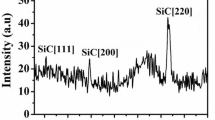Abstract
Silicon-based supercapacitors are highly essential for the utilization of supercapacitor technology in consumer electronics, owing to their on-chip integration with the well-established complementary metal–oxide–semiconductor-related fabrication technology. In this study, silicon nanowalls were carved on commercially available silicon wafers by using a facile, low-cost and complementary metal–oxide–semiconductor compatible method of metal (silver)-assisted chemical etching. The electron microscopic studies of the carved out silicon nanowalls reveal that they are smooth, single crystalline and vertically aligned to their base silicon wafer. Raman and ATR-FTIR spectroscopy confirm that the surface of the silicon nanowalls has Si–O–Si bonded structures. Cyclic voltammetry (CV) and galvanostatic charge–discharge (GCD) studies were carried out in the organic electrolyte tetraethylammonium tetrafluroborate (NEt4BF4) in propylene carbonate (PC). It is evident from both the CV and GCD studies that the silicon nanowalls exhibit redox peaks arising from the silver-related deep-level trap state in silicon in contact with adsorbed water and also from the oxidation of silicon and its hydrides by the water present in the electrolyte. The presence of silver in silicon nanowalls and water in the electrolyte are considered to be due to the minute amount of silver left over during its removal by HNO3, owing to the bunching of nanowalls and the highly moisture sensitive nature of the electrolyte, respectively. The influence of such redox peaks on capacitance and cycle life are discussed.






Similar content being viewed by others
References
Gür T M 2018 Energy Environ. Sci. 11 2696
González A, Goikolea E, Barrena J A and Mysyk R 2016 Renew. Sust. Energ. Rev. 58 1189
Yan Y, Luo Y, Ma J, Li B, Xue H and Pang H 2018 Small 14 1801815
Sharma K, Arora A and Tripathi S K 2019 J. Energy Storage 21 801
Najib S and Erdem E 2019 Nanoscale Adv. 1 2817
Gaboriau D, Aradilla D, Brachet M, Le Bideau J, Brousse T, Bidan G et al 2016 RSC Adv. 6 81017
Alper J P, Vincent M, Carraro C and Maboudian R 2012 Appl. Phys. Lett. 100 163901
Alper J P, Wang S, Rossi F, Salviati G, Yiu N, Carraro C et al 2014 Nano Lett. 14 1843
Chatterjee S, Carter R, Oakes L, Erwin W R, Bardhan R and Pint C L 2014 J. Phys. Chem. C 118 10893
Tao B, Zhang J, Miao F, Hui S and Wan L 2010 Electrochim. Acta 55 5258
Thissandier F, Gentile P, Brousse T, Bidan G and Sadki S 2014 J. Power Sources 269 740
Thissandier F, Gentile P, Pauc N, Brousse T, Bidan G and Sadki S 2014 Nano Energy 5 20
Huang Z, Geyer N, Werner P, De Boor J and Gösele U 2011 Adv. Mater. 23 285
Behera A K, Viswanath R, Lakshmanan C, Madapu K, Kamruddin M and Mathews T 2019 Microporous Mesoporous Mater. 273 99
Behera A K, Viswanath R, Lakshmanan C, Polaki S, Sarguna R and Mathews T 2018 AIP Conf. Proc., AIP Publishing LLC p 050062
Behera A K, Viswanath R, Lakshmanan C, Mathews T and Kamruddin M 2020 Nano-Struct. Nano-Objects 21 100424
Li B, Yu D and Zhang S-L 1999 Phys. Rev. B 59 1645
Wang R-P, Zhou G-W, Liu Y-I, Pan S-H, Zhang H-Z, Yu D-P et al 2000 Phys. Rev. B 61 16827
Tsu R, Shen H and Dutta M 1992 Appl. Phys. Lett. 60 112
Sailor M J 2012 Porous silicon in practice: preparation, characterization and applications (New York: John Wiley & Sons)
Sun X, Wang S, Wong N, Ma D, Lee S and Teo B K 2003 Inorg. Chem. 42 2398
Canham L 2014 Handbook of porous silicon (Berlin: Springer)
Peng K, Hu J, Yan Y, Wu Y, Fang H, Xu Y et al 2006 Adv. Funct. Mater. 16 387
Peng K, Lu A, Zhang R and Lee S T 2008 Adv. Funct. Mater. 18 3026
Shougee A, Konstantinou F, Albrecht T and Fobelets K 2017 IEEE Trans. Nanotechnol. 17 154
Fobelets K, Li C, Coquillat D, Arcade P and Teppe F 2013 RSC Adv. 3 4434
McSweeney W, Lotty O, Mogili N V V, Glynn C, Geaney H, Tanner D et al 2013 J. Appl. Phys. 114 034309
Liu M-P, Li C-H, Du H-B and You X-Z 2012 Chem. Commun. 48 4950
Ortaboy S, Alper J P, Rossi F, Bertoni G, Salviati G, Carraro C et al 2017 Energy Environ. Sci. 10 1505
Ghosh S, Mathews T, Gupta B, Das A, Krishna N G and Kamruddin M 2017 Nano-Struct. Nano-Objects 10 42
Wu D, Xu S, Li M, Zhang C, Zhu Y, Xu Y et al 2015 J. Mater. Chem. A 3 16695
Acknowledgements
We are thankful to DAE, Government of India, for providing the financial support. We also thank P K Ajikumar, S Amirthapandian and K K Madapu for SEM, TEM and Raman measurements, respectively. We acknowledge UGC-DAE CSR Kalpakkam Node for the experimental support. RNV is grateful to Vinayaka Mission Research Foundation, Chennai 603 104, for the research support and encouragement.
Author information
Authors and Affiliations
Corresponding author
Rights and permissions
About this article
Cite this article
Behera, A.K., Lakshmanan, C., Viswanath, R.N. et al. Electrochemical studies on wafer-scale synthesized silicon nanowalls for supercapacitor application. Bull Mater Sci 43, 291 (2020). https://doi.org/10.1007/s12034-020-02272-7
Received:
Accepted:
Published:
DOI: https://doi.org/10.1007/s12034-020-02272-7




